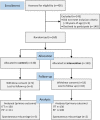Preventing hemorrhoids during pregnancy: a multicenter, randomized clinical trial
- PMID: 35490229
- PMCID: PMC9055760
- DOI: 10.1186/s12884-022-04688-x
Preventing hemorrhoids during pregnancy: a multicenter, randomized clinical trial
Abstract
Background: To compare specific dietary and behavioral recommendations for hemorrhoids prevention during pregnancy.
Methods: This was a randomized, single-blind, multicenter trial conducted in three different clinical centers. Patients were randomly allocated into two groups in a ratio of 1:1. Intervention consisted of specific dietary and behavioral counseling. The primary outcome of this study was the rate of hemorrhoids at the time of discharge from the obstetrics unit. Categorical variables were compared by the Chi-Squared or Fisher exact tests, as appropriate. Continuous variables were compared using either the Student's t-test or the Mann-Whitney U test. Binary logistic regression model was used to identify independent predictors of hemorrhoids after delivery. This analysis was performed on factors with a p-value < 0.10 in univariate analysis. Statistical analysis was performed using IBM SPSS 23.0 and GraphPad Prism 9 software. A P-value of less than 0.05 was considered significant for all tests.
Results: We observed a significantly lower hemorrhoids rate in the intervention group at the time of discharge from the obstetrics unit after delivery (intention-to-treat (ITT) (the relative risk (RR) 0.38; 95% the confidence interval (CI) 0.24-0.59; p < 0.001) per-protocol (PP) (RR 0.42; 95% CI 0.27-0.64; p < 0.001). There was no significant difference in spontaneous miscarriage rate between the groups for both ITT and PP analysis. Additional binary logistic regression analysis revealed that the intervention applied in this study was the only protective factor. Both, the history of hemorrhoids before pregnancy and the increase of newborn height was associated with a higher risk of hemorrhoids.
Conclusions: Our suggested intervention, aimed to modify dietary and behavioral habits, significantly reduces the rate of hemorrhoids after pregnancy and can be safely recommended to pregnant women.
Trial registration: Date of registration: 2016-05-09; Date of initial patient enrollment: 2016-06-02; Trial registration number: 158200-16-843-357; Trial registration site URL: https://www.mf.vu.lt/mokslas/vilniaus-regioninis-biomedicininiu-39tyrimu-etikos-komitetas#isduoti40vrbtek-leidimai .
Keywords: Hemorrhoids; Nutrition; Pregnancy; Prevention.
© 2022. The Author(s).
Conflict of interest statement
This study was initiated and run by Faculty of Medicine, Vilnius University, Vilnius, Lithuania, and is a part of a Ph.D. research project of Zivile Sabonyte-Balsaitiene. The authors have not declared a specific grant for this research from any funding agency in the public, commercial or not-for-profit sectors.
Figures
References
-
- Poskus T, Buzinskienė D, Drasutiene G, Samalavicius N, Barkus A, Barisauskiene A, et al. Haemorrhoids and anal fissures during pregnancy and after childbirth: a prospective cohort study. BJOG: An International Journal of Obstetrics & Gynaecology. 2014;121:1666–71. - PubMed
-
- Abramowitz L, Sobhani I, Benifla JL, Vuagnat A, Daraï E, Mignon M, et al. Anal Fissure and Thrombosed External Hemorrhoids Before and After Delivery: Diseases of the Colon & Rectum. 2002;45:650–655. - PubMed
Publication types
MeSH terms
LinkOut - more resources
Full Text Sources
Medical
Miscellaneous



